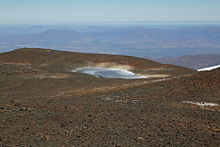


The Plomo Mummy (also known as Boy of El Plomo, El Plomo Mummy, or La Momia del Cerro El Plomo in Spanish) is the well-preserved remains of an Incan child found on Cerro El Plomo near Santiago, Chile in 1954.[1] It was the first frozen mummy discovery of high-altitude human sacrifice by the Incas,[2] a practice called qhapaq hucha.
The mummy is curated by the National Museum of Natural History in Santiago, Chile, where a replica of the mummy is on public display. In 2003, histological examinations of the remains revealed the presence of a primitive species of the Trichinella parasite.
See also
editReferences
edit- ^ Tierney, Patrick (1990). The highest altar : unveiling the mystery of human sacrifice. New York, N.Y., U.S.A.: Penguin Books. ISBN 978-0140139747.
- ^ Clark, Liesl (November 24, 1998). "Ice Mummies of the Inca". pbs.org. Retrieved 24 July 2012.
The first frozen high mountain Inca human sacrifice was found atop a peak in Chile in 1954.
- Aufderheide, Arthur C. (2010). The scientific study of mummies. Cambridge: Cambridge University Press. ISBN 978-0521177351. Retrieved 24 July 2012. (p. 126, 157)
- Wheeler, Margaret (1967). History Was Buried: A Source Book of Archaeology. Bbs Budget Book Svs. ISBN 978-0883652855. (p. 381)
External links
editCategory:Human remains (archaeological) Category:Archaeology of Chile Category:1954 archaeological discoveries Category:Mummies Category:Human sacrifice